OCZ Octane 128GB SSD Review
by Anand Lal Shimpi on December 28, 2011 12:27 AM ESTAnandTech Storage Bench 2011
Last year we introduced our AnandTech Storage Bench, a suite of benchmarks that took traces of real OS/application usage and played them back in a repeatable manner. I assembled the traces myself out of frustration with the majority of what we have today in terms of SSD benchmarks.
Although the AnandTech Storage Bench tests did a good job of characterizing SSD performance, they weren't stressful enough. All of the tests performed less than 10GB of reads/writes and typically involved only 4GB of writes specifically. That's not even enough exceed the spare area on most SSDs. Most canned SSD benchmarks don't even come close to writing a single gigabyte of data, but that doesn't mean that simply writing 4GB is acceptable.
Originally I kept the benchmarks short enough that they wouldn't be a burden to run (~30 minutes) but long enough that they were representative of what a power user might do with their system.
Not too long ago I tweeted that I had created what I referred to as the Mother of All SSD Benchmarks (MOASB). Rather than only writing 4GB of data to the drive, this benchmark writes 106.32GB. It's the load you'd put on a drive after nearly two weeks of constant usage. And it takes a *long* time to run.
1) The MOASB, officially called AnandTech Storage Bench 2011 - Heavy Workload, mainly focuses on the times when your I/O activity is the highest. There is a lot of downloading and application installing that happens during the course of this test. My thinking was that it's during application installs, file copies, downloading and multitasking with all of this that you can really notice performance differences between drives.
2) I tried to cover as many bases as possible with the software I incorporated into this test. There's a lot of photo editing in Photoshop, HTML editing in Dreamweaver, web browsing, game playing/level loading (Starcraft II & WoW are both a part of the test) as well as general use stuff (application installing, virus scanning). I included a large amount of email downloading, document creation and editing as well. To top it all off I even use Visual Studio 2008 to build Chromium during the test.
The test has 2,168,893 read operations and 1,783,447 write operations. The IO breakdown is as follows:
| AnandTech Storage Bench 2011 - Heavy Workload IO Breakdown | ||||
| IO Size | % of Total | |||
| 4KB | 28% | |||
| 16KB | 10% | |||
| 32KB | 10% | |||
| 64KB | 4% | |||
Only 42% of all operations are sequential, the rest range from pseudo to fully random (with most falling in the pseudo-random category). Average queue depth is 4.625 IOs, with 59% of operations taking place in an IO queue of 1.
Many of you have asked for a better way to really characterize performance. Simply looking at IOPS doesn't really say much. As a result I'm going to be presenting Storage Bench 2011 data in a slightly different way. We'll have performance represented as Average MB/s, with higher numbers being better. At the same time I'll be reporting how long the SSD was busy while running this test. These disk busy graphs will show you exactly how much time was shaved off by using a faster drive vs. a slower one during the course of this test. Finally, I will also break out performance into reads, writes and combined. The reason I do this is to help balance out the fact that this test is unusually write intensive, which can often hide the benefits of a drive with good read performance.
There's also a new light workload for 2011. This is a far more reasonable, typical every day use case benchmark. Lots of web browsing, photo editing (but with a greater focus on photo consumption), video playback as well as some application installs and gaming. This test isn't nearly as write intensive as the MOASB but it's still multiple times more write intensive than what we were running last year.
As always I don't believe that these two benchmarks alone are enough to characterize the performance of a drive, but hopefully along with the rest of our tests they will help provide a better idea.
The testbed for Storage Bench 2011 has changed as well. We're now using a Sandy Bridge platform with full 6Gbps support for these tests.
AnandTech Storage Bench 2011 - Heavy Workload
We'll start out by looking at average data rate throughout our new heavy workload test:
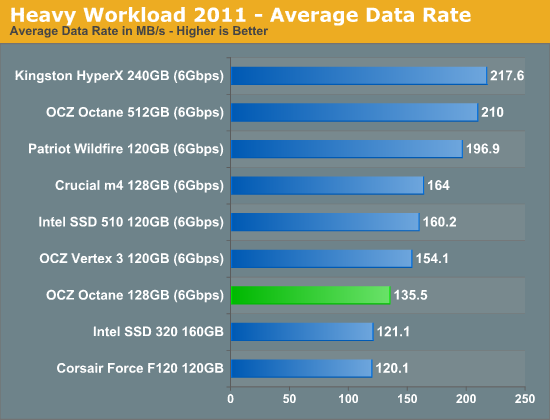
For write-heavy workloads the 128GB Octane is faster than the previous generation 3Gbps drives, but still a bit slower than the 6Gbps Intel, Crucial and SandForce based offerings.
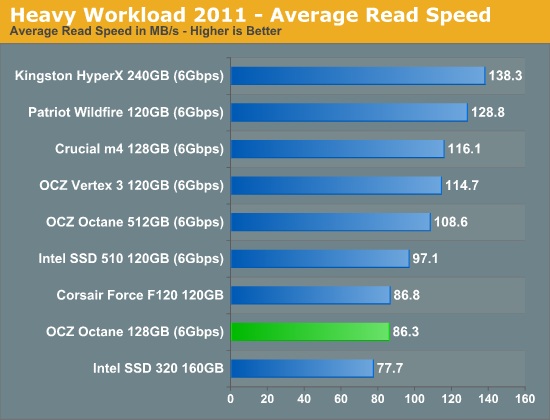

The next three charts just represent the same data, but in a different manner. Instead of looking at average data rate, we're looking at how long the disk was busy for during this entire test. Note that disk busy time excludes any and all idles, this is just how long the SSD was busy doing something:
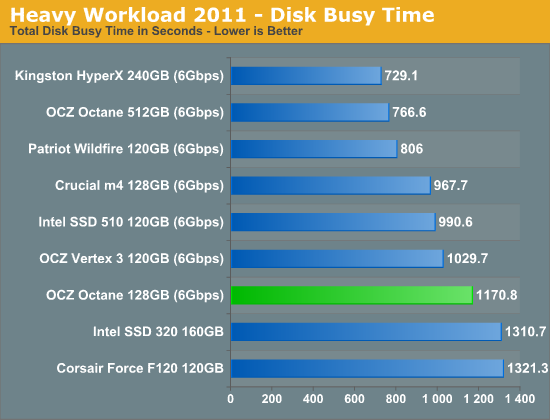
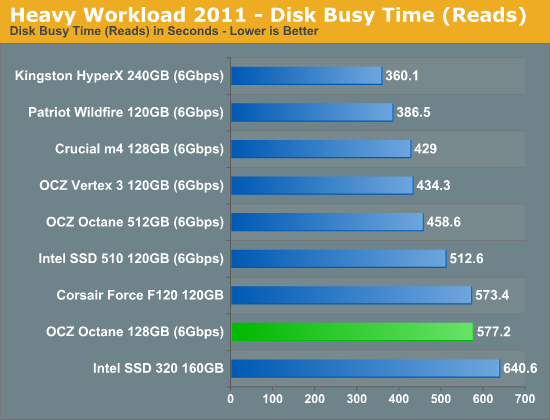
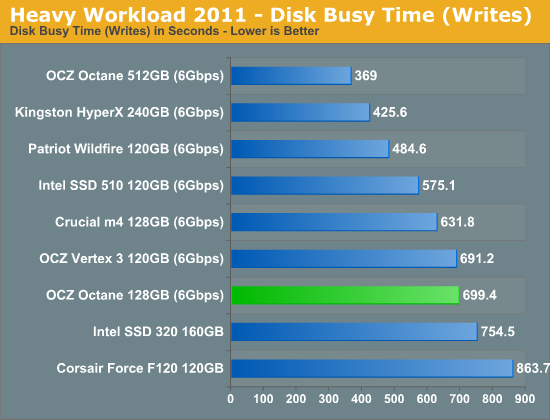










38 Comments
View All Comments
jramskov - Wednesday, December 28, 2011 - link
My desktop (i7-920 based, Win7 64bit) currently have a 160GB Intel G2 as a boot drive, but my data drive is currently an older 500GB Seagate.Workload: Primarily editing images in Lightroom, etc. (compressed RAW files from a Nikon D700 currently).
I would like to replace the Seagate with a 256GB SSD, but which one would be recommended for such a workload?
Denithor - Wednesday, December 28, 2011 - link
Standard recommendations are:Intel 320
Crucial M4
Samsung 830
All are known for high dependability. Last two use sata III controllers, which you do not currently have on your system, but would become faster when you eventually upgrade your system. (And will therefore remain competitive longer.)
jramskov - Wednesday, December 28, 2011 - link
Thanks.I was thinking along those lines and not the Sandforce based as I'm generally working with compressed data.
And true, I don't have sata III controllers, but I don't think my system is worth upgrading just yet :)
JackF - Wednesday, December 28, 2011 - link
I have a similar system (i930) and currently have a OCZ Max IOPs 120gb for my boot drive, and an OCZ Vertex 3 120gb as my game drive (along with a 600gb Velociraptor for data).When I first got the MAX IOPs drive, I had occasional issues with the drive disappearing (would need a reboot), but with the firmware updates, this drive has been running for 2-3 months with no problems. I never had any problems with the Vertex 3, but I got it later and it had newer firmware.
I think the reliability issues have been resolved with the Sandforce 2281 controller and I would not rule these out as they have come down in price.
Even if you add an SSD for working with your large photo data, Keep the Seagate as a data back-up.
jramskov - Thursday, December 29, 2011 - link
I was avoiding the Sandforce based SSD's because they are best for data that can be compressed, my images are already compressed. Images are relatively big (spanning from 5-15MB or so), so my thinking is that I should be looking at sequential read/write performance and less on random read/write performance.I have no doubt though that almost no matter what SSD I choose, I will get a quite nice performance boost.
JonnyDough - Wednesday, December 28, 2011 - link
He could also get a SATA 6GB/s controller card.ckevin1 - Wednesday, December 28, 2011 - link
Be careful of this -- the total bandwidth of a PCI-e 1x slot is only 500 mb/s. That's less than the maximum SATA III speed, and if you hook up more than one drive you could actually cap out at less than SATA II performance for each disk.Maybe there are more expensive adapter cards that plug into a different PCI-e slot, but I would be inclined to only rely on motherboard connections for true SATA III speeds for the time being.
StanFL - Wednesday, December 28, 2011 - link
Good review. In the last paragraph on the final page, myriad is spelled incorrectly.Denithor - Wednesday, December 28, 2011 - link
No spell checker? Sheesh...JonnyDough - Wednesday, December 28, 2011 - link
You must be new here. And by here I mean the internet...Education in America is at an all time low.